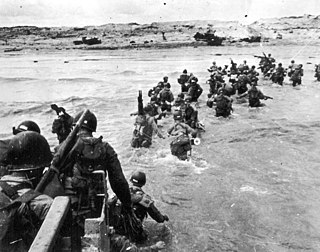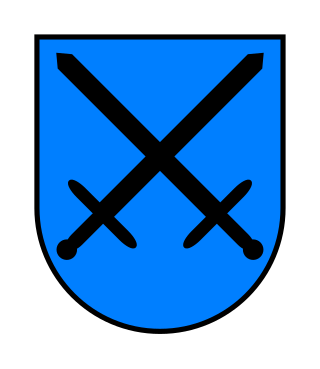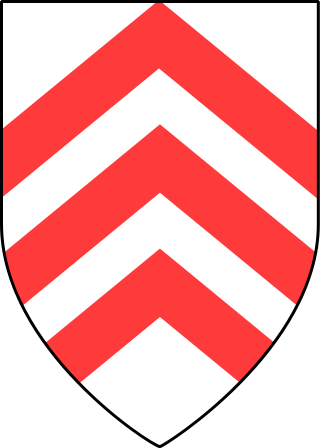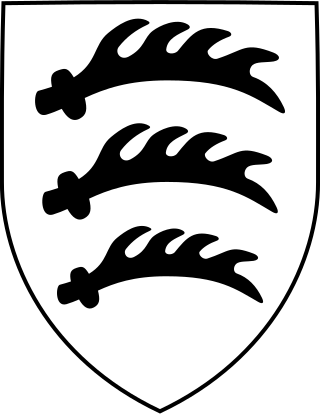
Utah, commonly known as Utah Beach, was the code name for one of the five sectors of the Allied invasion of German-occupied France in the Normandy landings on June 6, 1944 (D-Day), during World War II. The westernmost of the five code-named landing beaches in Normandy, Utah is on the Cotentin Peninsula, west of the mouths of the Douve and Vire rivers. Amphibious landings at Utah were undertaken by United States Army troops, with sea transport, mine sweeping, and a naval bombardment force provided by the United States Navy and Coast Guard as well as elements from the British, Dutch and other Allied navies.

The 716th Static Infantry Division was a World War II, German Army infantry division. It was raised on May 2, 1941, and sent to German-occupied France in June 1941. Many of the division's troops were elderly Germans and conscripts from other German-occupied countries. The division also had some young German conscripts as well. As a bodenständig it was not equipped with the standard configuration of vehicles and heavy weapons. Much of the division's artillery and anti-tank guns were from captured armaments.

The 709th Static Infantry Division was a German Army infantry division in World War II. It was raised in May 1941 and used for occupation duties during the German occupation of France in World War II until the Allied invasion. It was on the Normandy coast when the invasion occurred and so fought in the Battle of Normandy. The division was trapped in the Cotentin Peninsula and destroyed in the defense of Cherbourg.

The 243rd Static Infantry Division was an infantry division of the German Army raised in July 1943. It was stationed in the Cotentin Peninsula when the Allies invaded in June 1944.

The Brécourt Manor Assault during the U.S. parachute assault of the Normandy Invasion of World War II is often cited as a classic example of small-unit tactics and leadership in overcoming a larger enemy force.
This is the complete order of battle of Allied and German forces involved during Operation Market Garden.

The 275th Infantry Division was an infantry division of the German Army during World War II.

The 6th Infantry Division was a unit of the German Army during World War II.

Wilhelm Falley was the first German general to be killed during the Normandy landings in France. He was commander of the 91st Infantry Division.

American airborne landings in Normandy were a series of military operations carried by the United States as part of Operation Overlord, the invasion of Normandy by the Allies on June 6, 1944, during World War II. In the opening maneuver of the Normandy landings, about 13,100 American paratroopers from the 82nd and 101st Airborne Divisions, then 3,937 glider infantrymen, were dropped in Normandy via two parachute and six glider missions.
The American airborne landings in Normandy order of battle is a list of the units immediately available for combat on the Cotentin Peninsula between June 6, 1944, and June 15, 1944, during the American airborne landings in Normandy during World War II.

Mission Albany was a parachute combat assault at night by the U.S. 101st Airborne Division on June 6, 1944, part of the American airborne landings in Normandy during World War II. It was the opening step of Operation Neptune, the assault portion of the Allied invasion of Normandy, Operation Overlord. Five hours ahead of the D-Day landings, 6,928 paratroopers jumped from 443 C-47 Skytrain troop-carrier planes into the southeast corner of France's Cotentin Peninsula. The troops were meant to land in an area of roughly 15 square miles (39 km2), but were scattered by bad weather and German ground fire over an area twice as large, with four sticks dropped as far as 20 miles (32 km) away.
Mission Boston was a parachute combat assault at night by Major General Matthew Ridgway's U.S. 82nd Airborne Division on June 6, 1944, part of the American airborne landings in Normandy during World War II. Boston was a component element of Operation Neptune, the assault portion of the Allied invasion of Normandy, codenamed Operation Overlord. 6,420 paratroopers jumped from nearly 370 Douglas C-47 Skytrain troop carrier aircraft into an intended objective area of roughly 10 square miles (26 km2) located on either side of the Merderet river on the Cotentin Peninsula of France, five hours ahead of the beach landings.

The 25th Infantry Division was a military unit of the German Wehrmacht. It was later reclassified to 25th Motorized Infantry Division, and in June 1943 to the 25th Panzergrenadier Division.

The 319th Static Infantry Division was a German Army static division during World War II. It was raised in November 1940 from units of the 87th, 169th and the 299th Infantry Divisions. On 30 April 1941 the 319th Division replaced the 216th Infantry Division in the Channel Islands defense and remained in that position until its capture in May 1945 by British forces.

The 50th Infantry Division was a German army division in World War II. It was formed on 26 August 1939 from the Grenzkommandantur Küstrin.

The 65th Infantry Division was a German division in World War II. It was formed in July 1942.
The 49th Infantry Division was a military formation of the German Heer (Army) which served during the later years of the Second World War.
The 416th Infantry Division was a German infantry division of World War II.
The 330th Infantry Division was an infantry division of the German army during World War II. It was active between 1941 and 1943.














